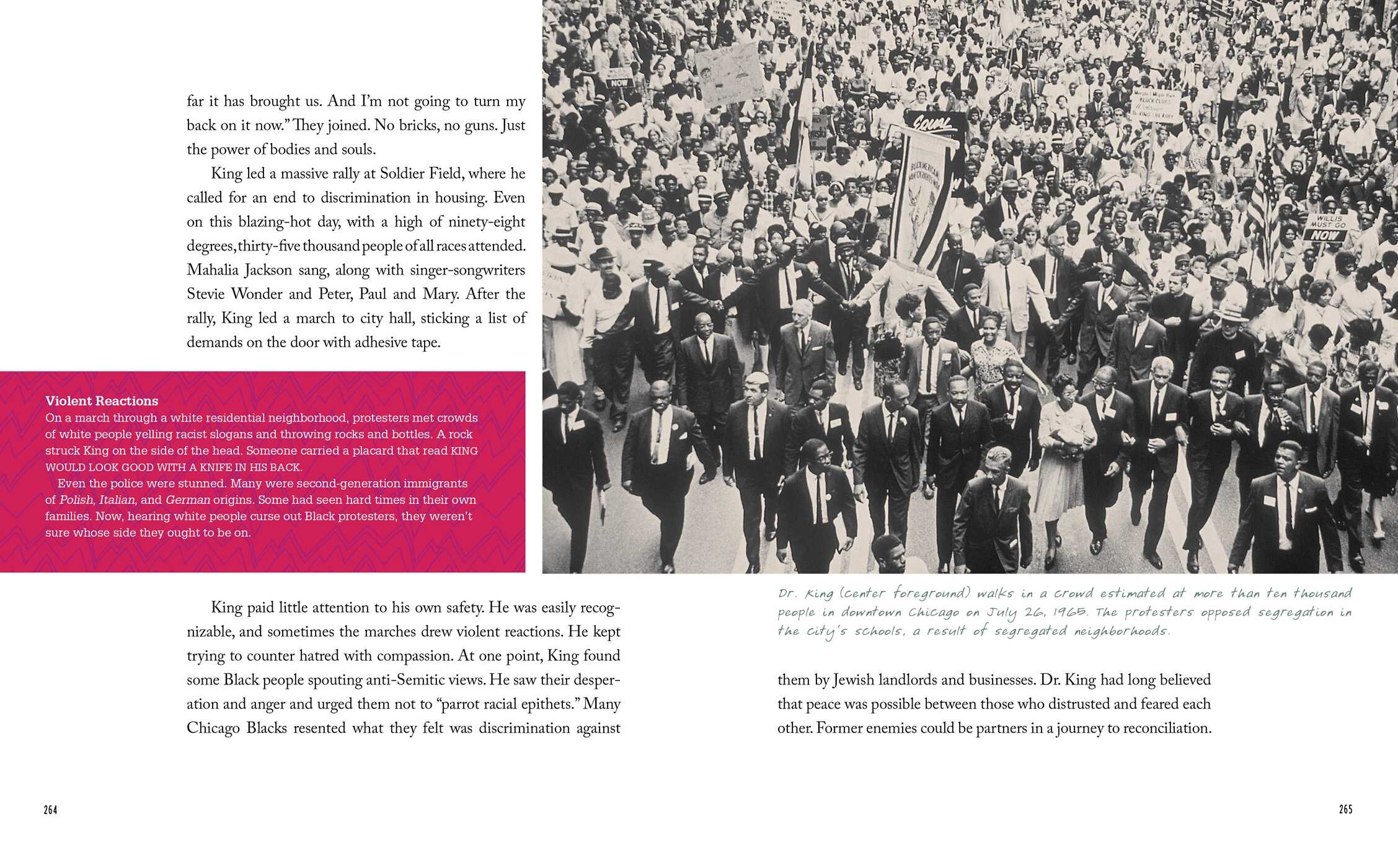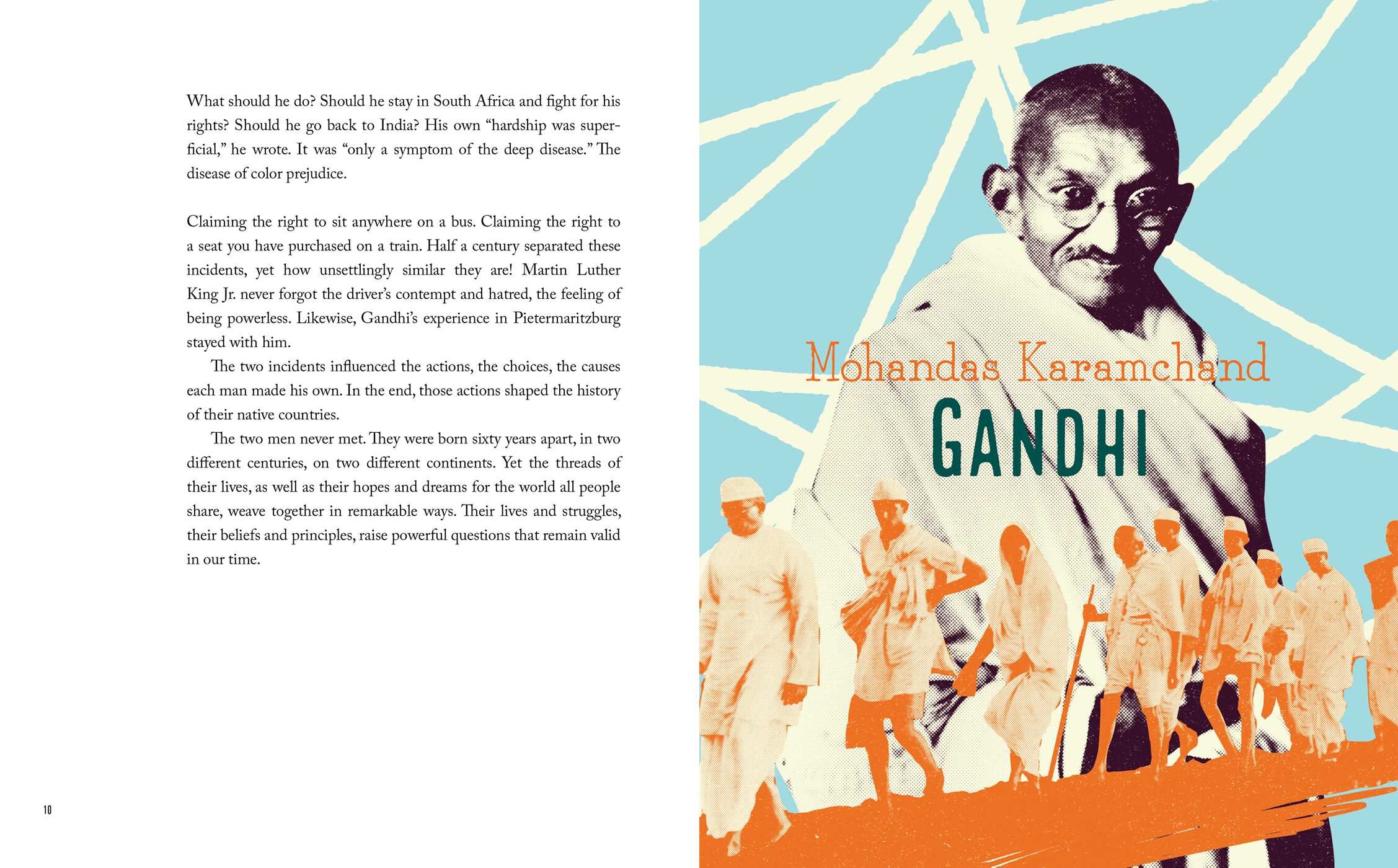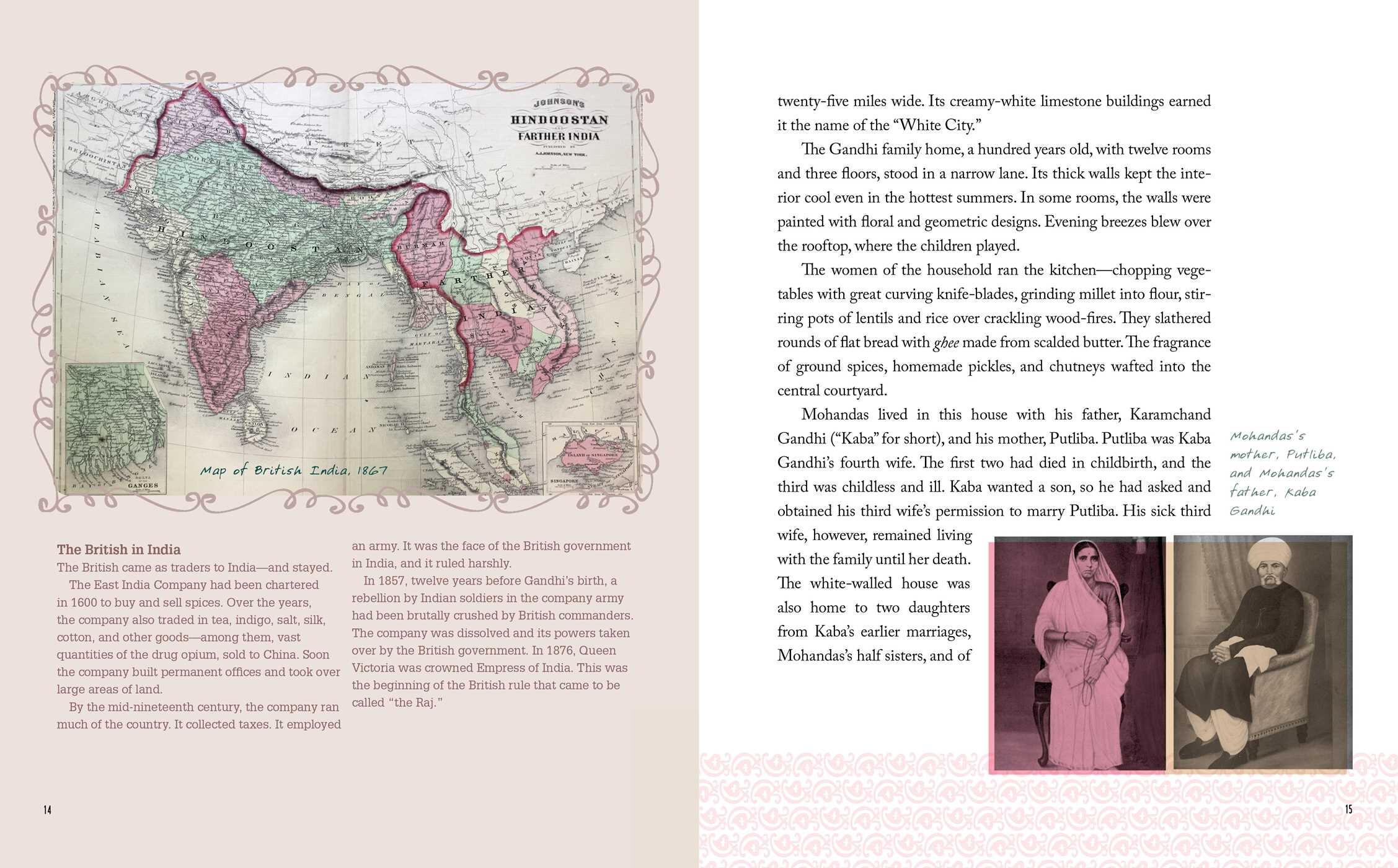Plus get our latest book recommendations, author news, and competitions right to your inbox.
Threads of Peace
How Mohandas Gandhi and Martin Luther King Jr. Changed the World
Table of Contents
About The Book
Mohandas Gandhi and Reverend Martin Luther King Jr. both shook and changed the world in their quest for peace among all people, but what threads connected these great activists together in their shared goal of social revolution?
A lawyer and activist, tiny of stature with giant ideas, in British-ruled India at the beginning of the 20th century.
A minister from Georgia with a thunderous voice and hopes for peace at the height of the civil rights movement in America.
Born more than a half-century apart, with seemingly little in common except one shared wish, both would go on to be icons of peaceful resistance and human decency. Both preached love for all human beings, regardless of race or religion. Both believed that freedom and justice were won by not one, but many. Both met their ends in the most unpeaceful of ways—assassination.
But what led them down the path of peace? How did their experiences parallel...and diverge? Threads of Peace keenly examines and celebrates these extraordinary activists’ lives, the threads that connect them, and the threads of peace they laid throughout the world, for us to pick up, and weave together.
Reading Group Guide
Join our mailing list! Plus get our latest book recommendations, author news, and competitions right to your inbox.
Threads of Peace: How Mohandas Gandhi and Martin Luther King Jr. Changed the World
By Uma Krishnaswami
About the Book
Born more than half a century apart, Mohandas Gandhi and Dr. Martin Luther King Jr. share more commonalities than differences. Gandhi was an Indian lawyer and activist who fought for India’s independence from British rule and for the civil rights of Indians living in South Africa.
King was a pastor and activist who led the American Civil Rights Movement to end inequalities and the unfair treatment of Black people. While their cultures and contexts are different, their paths of peaceful resistance are shockingly similar. Both practiced nonviolence and believed in the importance of showing love and kindness toward all, and the parallels of their approach and the success they both found as a result will energize generations to come. With an inviting layout complete with captivating primary documents and photographs, Threads of Peace thoughtfully examines the lives of these activists, fleshing out every angle of their humanity and their fight for the fully realized humanity of others.
Discussion Questions
1. Have you observed acts of nonviolent resistance in your life thus far? If so, do you believe the efforts were successful? Explain why or why not.
2. Gandhi and Dr. King both practiced nonviolent resistance, though their worlds, cultures, and contexts were different. What do you believe we can learn from studying these two men together?
3. Dr. King actively encouraged and involved young people in his efforts toward civil rights. Why do you think he did this? What, in your opinion, are the benefits and drawbacks of youth involvement in resistance movements?
4. Have you learned about Gandhi and Dr. King outside of school? If so, from whom? In what ways did reading Threads of Peace add or detract from what you had previously learned?
5. Threads of Peace includes detailed information regarding Gandhi’s and Dr. King’s childhoods and personal lives. Did any details or stories in particular stand out to you? If so, what? Why do you think you felt drawn to them?
6. Why do you think large social movements have to have a leader? How would you feel if you were a participant of a movement, but you were not publicly recognized for your efforts?
7. Do you believe that we have made significant progress in the fight against racism since the Civil Rights Movement? Why or why not?
8. Threads introduces several other figures who are less commonly discussed. Examples of this include Claudette Colvin and Joel Silverman. Were any figures new to you as you read King’s story? What interested you the most about their involvement and efforts?
9. Compare and contrast the major teachings of Hinduism and Christianity as practiced by Gandhi and Dr. King. What aspects of these belief systems do you notice are similar, and what are different?
10. How would you feel if you were in Dr. King’s shoes, leading the Civil Rights Movement with a wife and four children? Would you stop your efforts if it meant keeping them safe? Why or why not?
11. Compare and contrast some of the major acts of nonviolence in both Gandhi’s and King’s time periods. What do you notice?
12. Though they were adversaries, Officer Pritchett in many ways respected Dr. King’s nonviolent approach and matched it. Why do you think this was? Is it possible to both oppose and respect a person? A movement? Discuss examples.
13. Why do you think the author spent so much time detailing the personal lives of Gandhi’s and King’s assassins? In what ways did this information color your interpretation of history?
14. What do you believe is the connection between racism, poverty, and independence? Use examples from the text to support your answer.
15. Marches and pilgrimages were central to both Gandhi’s and Dr. King’s movements. Discuss what you believe is the power in these specific displays of nonviolent resistance.
16. If you had to lead a nonviolent resistance, what would be the cause? What approaches and strategies would you borrow from Gandhi or Dr. King? What are some new approaches you would like to enact?
17. From Gandhi’s childhood, we learn that with the right motivation, we can grow into great purpose and success. Were you at all surprised when you read about Gandhi’s young life? How did reading this part of his life influence how you think of him? Yourself? Those around you?
18. As part of his efforts, Dr. King traveled to India to learn more about Gandhi’s movement and approaches. Using evidence from the text, how did this trip influence Dr. King’s actions upon his return?
19. Gandhi spent his early adulthood trying to fit into British culture, though he later began to embrace and emphasize his Indian roots. Have you ever felt like you had to change something about yourself to fit in at school? In a club or activity? If so, how did that make you feel?
20. Who do you believe has more power to enact social change—citizens or the government? Support your response with examples from the text.
21. In many religions, fasting is used to provide clarity of mind and closeness with one’s god. Gandhi used fasting as a tool to prevent fighting and to unite the Hindus and Muslims in India. Why do you think he did this? Why do you believe this approach was effective, if at all?
22. Threading cloth was in many ways a literal and metaphoric symbol of India’s freedom and independence. Discuss the impact of cloth threading on India and beyond.
23. In your opinion, why do instances of violence break out in protests, despite nonviolent approaches to organizing?
24. Kasturba, Gandhi’s wife, is credited with shifting his outlook on respect and obedience not only in marriage, but in life. Is there a special family member or person in your life who has influenced your outlook on life?
Extension Activities
1. Extending the Threads of Peace
Gather some yarn or another threadlike material with significant length. On your own, spend two minutes with a single piece of thread and see what you can create. Next, meet with a partner and repeat the process. Finally, gather as a whole group and see what you can create all together.
Once completed, reflect on the process. What was easy? What was difficult? How did your creations differ as you added people to the process? Finally, consider this question: How can we build threads of peace not only within our communities, but across time?
2. An Imagined Dialogue
Imagine, for a moment, that Gandhi and Dr. King were able to gather for a conversation. Using what you know about each individual, take turns role-playing a conversation between the two men. Before starting, draft a few topics that you would like to see discussed. These do not need to be limited to their life spans.
Did any interesting ideas arise from your dialogue? Any realizations, agreements, or disagreements?
3. The Texts That Guide and Define Us
Gandhi and Dr. King both relied heavily on certain texts that outlined their stances on nonviolent resistance. These included the Bible, Ruskin’s Unto This Last, and the works of Henry David Thoreau. Think of a text that you believe closely defines one or many of your closely held values or beliefs. What is it? Write an essay in which you describe your text of choice, share a direct quotation, and explain how this text has defined your values.
4. The Human behind the Hero
Choose a moment in the life of either Gandhi or Dr. King. Research that moment to get a better idea of the time, the environment, and especially the mood. From your research, create a visual to share your findings. This could be a slideshow, poster, or another approach.
With others, discuss the impact of these human details on your understanding of Gandhi and Dr. King. How does knowing these small facts help you to better understand these two heroes?
5. Learning from the Patterns of History
Despite the different time periods and reasons for resistance, we know that there are various areas of overlap in Gandhi’s and Dr. King’s lives. Using this knowledge and what you know of social conflicts in our present day, outline a plan for your own nonviolent resistance movement.
Be sure to address the following:
What is your cause?
Who is impacted by this?
What nonviolent methods will you use?
What is your intended outcome?
How will you measure or identify success?
Books Like Threads of Peace
This Promise of Change: One Girl’s Story in the Fight for School Equality by Jo Ann Allen Boyce and Debbie Levy
Resist: 40 Profiles of Ordinary People Who Rose Up against Tyranny and Injustice by Veronica Chambers
We Will Not Be Silent: The White Rose Student Resistance Movement That Defied Adolf Hitler by Russell Freedman
Claudette Colvin: Twice Towards Justice by Phillip Hoose
We Rise, We Resist, We Raise Our Voices, edited by Wade Hudson and Cheryl Willis Hudson
March: Book One by John Lewis, Andrew Aydin, and Nate Powell
I Am Malala: How One Girl Stood Up for Education and Changed the World (Young Readers Edition) by Malala Yousafzai and Patricia McCormick
Books by Uma Krishnaswami
Two at the Top: A Shared Dream of Everest
Book Uncle and Me
Out of the Way! Out of the Way!
The Girl of the Wish Garden
The Grand Plan to Fix Everything
The Problem with Being Slightly Heroic
Step Up to the Plate, Maria Singh
For a complete list of titles by Uma Krishnaswami visit https://www.umakrishnaswami.com/.
Melanie Kirkwood Marshall holds a BA in Secondary English Education from the University of Wisconsin-Madison and a M.Ed in Reading Education from the University of Illinois at Urbana-Champaign. She has taught in many learning contexts from High School ELA teacher to Primary Literacy Interventionist. Currently, Melanie is completing her doctoral studies in Multicultural Children’s Literature at the University of Illinois at Urbana-Champaign.
This guide has been provided by Simon & Schuster for classroom, library, and reading group use. It may be reproduced in its entirety or excerpted for these purposes.
Product Details
- Publisher: Atheneum/Caitlyn Dlouhy Books (August 17, 2021)
- Length: 336 pages
- ISBN13: 9781481416801
- Ages: 9 - 14
Browse Related Books
Raves and Reviews
History has been carefully intertwined with the present in this engaging and reflective book.
– Kirkus Reviews, *STARRED REVIEW*, July 1, 2021
A reflective presentation that will inspire young peacemakers.
– Booklist *STARRED REVIEW*, August 1, 2021
An in-depth and well-researched volume that complements existing YA biographies on these two individuals by forging a little-known connection between American Black activism and the Indian nonviolent movement.
– School Library Journal, October 1, 2021
Awards and Honors
- Kansas NEA Reading Circle List Junior Title
- Bank Street Best Children's Book of the Year Selection Title
Resources and Downloads
High Resolution Images
- Book Cover Image (jpg): Threads of Peace eBook 9781481416801
- Author Photo (jpg): Uma Krishnaswami Photograph courtesy of the author(0.1 MB)
Any use of an author photo must include its respective photo credit














